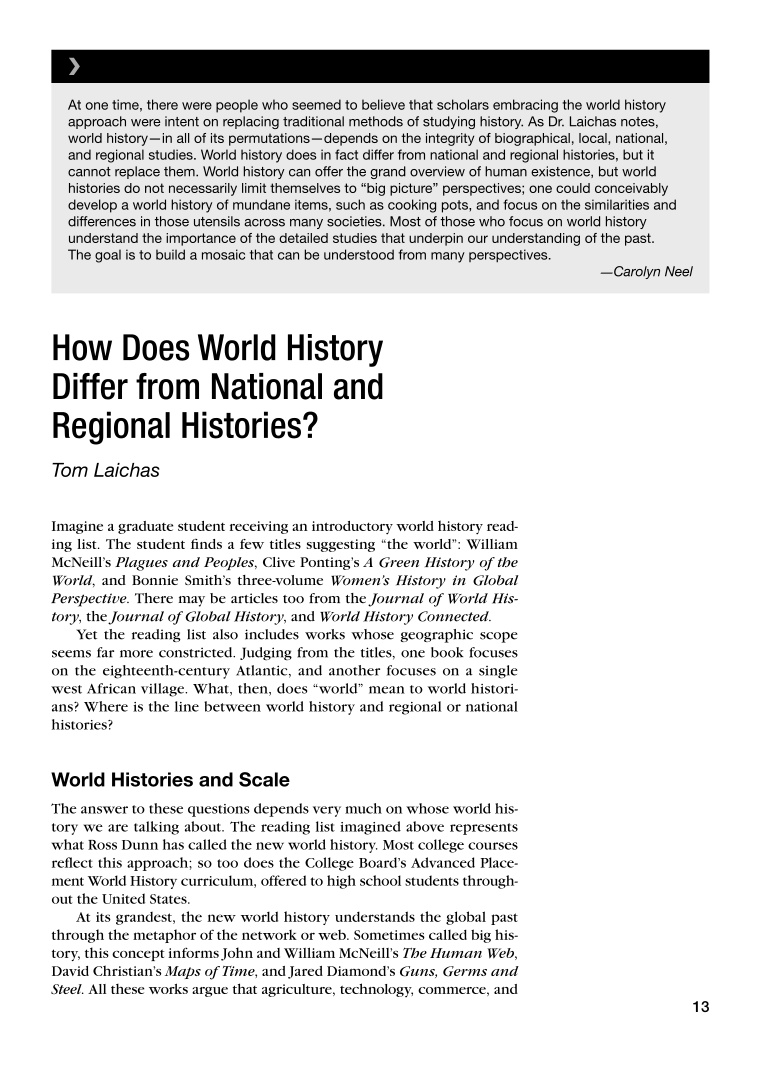13 At one time, there were people who seemed to believe that scholars embracing the world history approach were intent on replacing traditional methods of studying history. As Dr. Laichas notes, world history—in all of its permutations—depends on the integrity of biographical, local, national, and regional studies. World history does in fact differ from national and regional histories, but it cannot replace them. World history can offer the grand overview of human existence, but world histories do not necessarily limit themselves to “big picture” perspectives one could conceivably develop a world history of mundane items, such as cooking pots, and focus on the similarities and differences in those utensils across many societies. Most of those who focus on world history understand the importance of the detailed studies that underpin our understanding of the past. The goal is to build a mosaic that can be understood from many perspectives. —Carolyn Neel ❯❯ How Does World History Differ from National and Regional Histories? Tom Laichas Imagine a graduate student receiving an introductory world history read- ing list. The student finds a few titles suggesting “the world”: William McNeill’s Plagues and Peoples, Clive Ponting’s A Green History of the World, and Bonnie Smith’s three-volume Women’s History in Global Perspective. There may be articles too from the Journal of World His- tory, the Journal of Global History, and World History Connected. Yet the reading list also includes works whose geographic scope seems far more constricted. Judging from the titles, one book focuses on the eighteenth-century Atlantic, and another focuses on a single west African village. What, then, does “world” mean to world histori- ans? Where is the line between world history and regional or national histories? World Histories and Scale The answer to these questions depends very much on whose world his- tory we are talking about. The reading list imagined above represents what Ross Dunn has called the new world history. Most college courses reflect this approach so too does the College Board’s Advanced Place- ment World History curriculum, offered to high school students through- out the United States. At its grandest, the new world history understands the global past through the metaphor of the network or web. Sometimes called big his- tory, this concept informs John and William McNeill’s The Human Web, David Christian’s Maps of Time, and Jared Diamond’s Guns, Germs and Steel. All these works argue that agriculture, technology, commerce, and
Document Details My Account Print multiple pages
Print
You have printed 0 times in the last 24 hours.
Your print count will reset on at .
You may print 0 more time(s) before then.
You may print a maximum of 0 pages at a time.

























































































































































































































































































































































































































































































































































































































































































































































































































































































































































































































































































































































































































































































































































































































































































































































































































































































































































































































































































































































































































































































































































































































































































































































































































































































































































































































































































































































































































































































































































































































































































































































































































































































































































































































































































































































































































































































































































































































































































































































































































































































































































































































































































































































































































































































































































































































































































































































































































































































































































































































































































































































































































































































































































































































































































































































































































































































































































































































































































































































































































































































































































































































































































































































































































































































































































































































































































































































































































































































































































































































































































































































































































































































































































































































































































































































































































































































































































































































































































































































































































































































































































































































































































































































